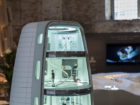How can we design the conditions for humans to thrive in outer space? This question is at the core of SOM’s specially commissioned installation for “Unknown Unknowns,” the 23rd Triennale Milano International Exhibition.
While sound and video are the most striking elements of the installation, “Decalogue for Space Architecture” began as a written text—an essay that emerged through conversations with the curator, astrophysicist Ersilia Vaudo, and a team of architects and engineers at SOM who have pursued concepts for space habitats through years of design and research.
Here we present the full text of the Decalogue: ten principles that should define a human-centered design approach for life beyond Earth.













